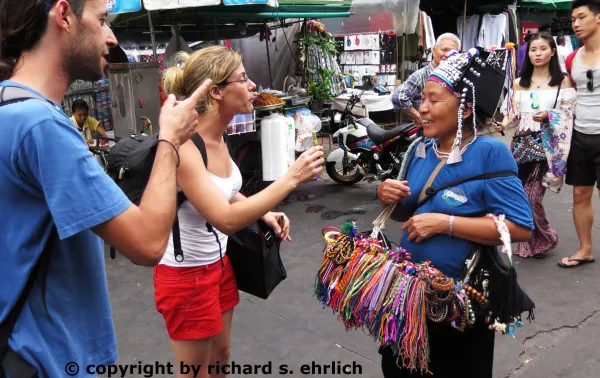
BANGKOK, Thailand -- A chubby Thai woman sits on a plastic sheet on
the ground, meticulously hand-sewing colorful wristbrands embroidered
with the words, "CUNT PAIN" "FUCK MY LIFE" "FREE BOOM BOOM" and an
array of similarly poetic declarations.
Other females, wearing the bubbly silver hats of Thailand's
minority ethnic Akha tribe, are selling gaudy gewgaws while stroking
wooden frogs which produce an obnoxious but attention-getting,
croaking sound.
Nearby, giddy foreigners chew fat black scorpions and other fried insects.
Some people are getting tattoos or having their hair braided with
bright plastic beads.
Throbbing and wondrous, Bangkok's amusing Khao San Road flaunts
itself at the swarms of sweaty culture-shocked tourists who are
walking and gawking at their first revelations in Thailand, hours
after arriving by air.
Other travelers are wistfully saying farewell during their last
night in Bangkok before departing to less vivid destinations.
The desperate, decadent touts have seen it all.
They cheerfully lure passersby on Bangkok's infamous walking
street, inviting people to indulge in cheap pleasures and costly
rip-offs.
Would Marco Polo stay on Khao San Road if such a sensuous and
sketchy street existed when he backpacked in the 13th century to hang
out with Kublai Khan?
Why not?
Ancient caravans often enjoyed the comforts offered by a welcoming oasis.
And this one bristles with Wi-Fi, travel agents, inexpensive
hotels, impressive restaurants, disco dive bars and other
entertainment venues.
Khao San's pleasures do not include the sexy striptease acts which
some people expect in Bangkok.
Those lurid thrills are across town in more modern neighborhoods.
But sleaziness is not far away, and some Khao San taxi drivers
anxiously offer an easy commute.
"Want body massage with sex?" a scruffy driver squawks at male
foreigners where taxis wait for customers.
"I have girl student for you with good body. She also massage. You want?"
Elsewhere, another man offers illegal drugs -- without mentioning
possible imprisonment -- and whispers:
"Smoke? Huh? You want? Smoke?"
Nestled among Bangkok's oldest neighborhoods and strolling distance
from the majestic Chao Phraya river, Khao San Road is pleasingly near
some of the capital's best sites.
These include the Grand Palace and Emerald Buddha, plus several
other important Buddhist temples.
But Khao San's biggest attractions are the intriguing souvenirs and
scrumptious food which ooze from its maze of interconnecting streets,
which form a day-and-night kaleidoscopic bazaar.
Clothing, books, art, jewelry, wholesale shops and illegal
counterfeit documents compete for customers alongside movie and music
DVDS.
Intoxicating massages are available on comfortable chaise lounges
parked on the sidewalk.
Small, shop-front "spas" allow fish to ticklishly nibble the dry
flesh off your feet while you soak your legs in a shallow tank of
water.
Sometimes you have to shout to be heard.
Outdoor cafes blare simultaneous rival soundtracks, hammering your
ears with a warped blur of rock, reggae, trance and traditional Thai.
Those countless restaurants provide very tasty cuisine, often in
sophisticated establishments with live music, exotic decor and other
flourishes.
Food-stained stalls in the street offer much cheaper Thai-style
fare including some just to fill your stomach, while others along the
sidewalk cook lots of recommended dishes.
"This is my first time to Thailand," said Ben, 19, a biomedical
student from England, eating dinner at a stall alongside his friend
Harry.
Ben and Harry slept in the Khao San neighborhood for two nights
when they arrived in Thailand.
Now -- 40 days after traveling around this Southeast Asian country
-- they have returned to the hostel for three more nights before
flying home.
"My sister stayed there last year, and she said she liked it. It's
a good place to stay. And it's cheap," Ben said in an interview.
What will he tell his friends back home about Khao San Road?
"On Khao San, we went to the reggae bar. Drank. Went to the Mexican
bar. Had some tequila. Went into a club -- I'm not actually sure where
that was. And then finished the night with a McDonald's and back to
bed," he said laughing.
"But don't stay in Khao San for too long. It's just too busy. It is
a lot of fun, but it's just too much all the time, every day, every
hour, every minute.
"I didn't 100 percent like it. It was fun for this short period of
time, but I just could not be here much longer.
"I think it's a good location as a base, because it's close to a
lot of the tourist attractions. And I think for somebody my age
especially, if you like going out and partying, then it's a good night
out," Ben said.
Harry, 20, a zoology student also from England, nodded while eating
and listening to Ben's description.
"Oh, I love it. Khao San is crazy, just full on," Harry said.
"You've just got to embrace it and go with the flow, because I
think if you take it too seriously, with everything pushed in your
face, it's quite intrusive and not that nice."
Harry said his weirdest interactions include "the Thai ladyboys,
scorpions being sold on the street, and just how in-your-face and
abrupt people are.
"And T-shirts with Hitler's face on them. And just very offensive
things that they find funny.
"We're going to buy scorpions probably tonight. And I'm going to
get a wristband for my housemate at home, because you can get them
handmade.
"So I'm going to get personal jokes like, 'GINGER FUCK' because
I've got a friend in our house and he has ginger hair, so it's sort of
like a running joke."
Harry did suffer verbal abuse from some frustrated vendors, similar
to his experiences in the souks of Marrakesh, Morocco.
On Khao San, a man shouted at him for "not buying their products,
the hammocks that they sell on the street," Harry said.
"It wasn't that bad. It was just like: 'Nobody likes you! Go away!
Get out of here!' I haven't heard any swear words yet."
Khao San's confrontations rarely get too insane.
Armed, uniformed police occupy a building at one end of the road
and also walk patrols.
Plainclothes police also provide security without freaking out
tourists, because Khao San is often named in security reports as a
possible soft target for terrorists along with Bangkok's other vibrant
sites.
"At night it is sometimes dangerous here, with people boxing each
other, drinking and having drugs," Prakash, a polite street tout from
Nepal, said while he tried to direct tourists to his employer's nearby
tailor shop.
"Here, tourists who have no money stay. Tourists with money come
only for shopping, and walk for maybe one or two hours, but they stay
on Sukhumvit Road," Prakash said, referring to Bangkok's upmarket,
glitzy, tourist-packed highway many miles away.
Omar, a visitor from Israel, agreed.
"For 400 baht (12 US dollars) you can stay in a Khao San guest
house, but it is shit. For a little bit more, maybe 500 baht (15 US
dollars), you can stay on Sukhumvit Road in a much better place," Omar
said while watching people walk by.
"Or even at a place 10 minutes walk from here where it gets
cheaper. But for these tourists here, Sukhumvit Road is scary. It is
big. It is a very long street. They don't know where to stay. On Khao
San, it is easy. Everything is here.
"Many tourists think Khao San is the place to be. That it is the
real Bangkok. But they don't know it's not. Thais do not hang out
here.
"If a Thai girl hangs out here, it is only for one thing, you
know?" Omar said.
Decades ago, when scruffy backpackers depended on word-of-mouth
recommendations, Khao San was one of the so-called "Three K's" of
Asia, which included Kathmandu in Nepal, and Kuta Beach on Indonesia's
island of Bali.
Unlike Kathmandu or Kuta, however, Khao San never offered a
hypnotic medieval ambiance or wave-slammed beach.
Also in the early days of backpacking -- in the 1960s and 1970s --
budget travelers often considered sprawling Bangkok as an unpleasant
"hole" to be avoided, because this city lacked many of the beatific
rewards found elsewhere.
As a result, Khao San was merely a pit-stop sanctuary compared to
those fabled destinations.
In recent years, opportunistic Thai developers belatedly realized a
new generation of cash-carrying tourists were milling aimlessly up and
down Khao San.
So Thais began upgrading the road's former mix of austere funk,
cliché cowboy motifs, gritty cheapness and weary insouciance.
Many of Khao San's original wooden guest houses were replaced by
flashy cement hotels at much higher prices.
Visiting the earliest hovels now seems like stepping back in time.
At the D.I.O. Oldest Guest House where you can stay for 180 baht
(about five US dollars), a quaint lobby offers a pool table, bar and
rustic atmosphere now often found mostly in Thailand's smaller towns.
As if proving it is trapped in the 1960s, the D.I.O.'s sound system
loudly plays the hippies' now-ludicrous, strangely gravity-inducing,
former hit theme song, "In a Gadda da Vida".
Today, most of Khao San prides itself as a snazzy,
government-supported, open stage for various cultural festivals
designed to attract tourists of every class.
For curious Thais, the neighborhood is a chance to see strange
foreign tribes, costumed and behaving in unimaginable ways.
Yes, Khao San Road is a ridiculous zoo.
An absurd urban trench.
A freakish soft parade.
But the road is also a lot of fun, and so diverse and hydra-headed
that it is worth visiting once.
And staying there -- albeit maybe just one night.
But travelers who want to experience Bangkok's real soul should
then bed elsewhere, even if it means staying in a much quieter
neighborhood.
That's because Bangkok's best backstreets and markets are places
where not many foreigners roam.
